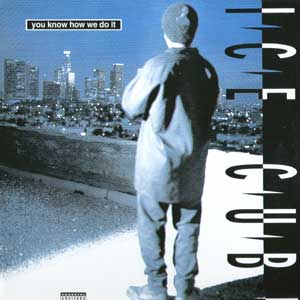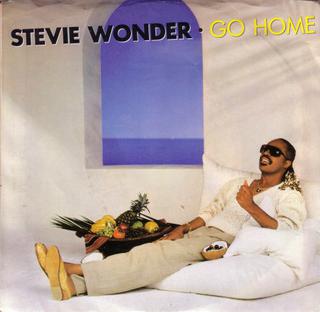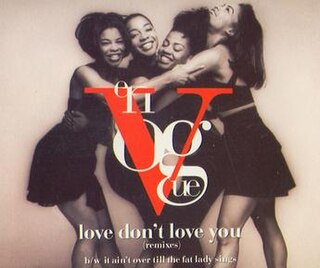Jazz rap is a fusion of jazz and hip hop music, as well as an alternative hip hop subgenre, that developed in the late 1980s and early 1990s. AllMusic writes that the genre "was an attempt to fuse African-American music of the past with a newly dominant form of the present, paying tribute to and reinvigorating the former while expanding the horizons of the latter." The rhythm was rooted in hip hop over which were placed repetitive phrases of jazz instrumentation: trumpet, double bass, etc. Groups involved in the formation of jazz rap included A Tribe Called Quest, Digable Planets, De La Soul, Gang Starr, The Roots, Jungle Brothers, and Dream Warriors.
Us3 were a British jazz rap group founded in London in 1992. Their name was inspired by a Horace Parlan album, titled Us Three, produced by Alfred Lion, the founder of Blue Note Records. On their debut album, Hand on the Torch, Us3 exclusively used samples from the Blue Note catalogue, all originally produced by Lion.

Hand on the Torch is the debut studio album by British jazz rap group Us3. It received much attention because of its mixture of jazz with hip-hop music, with material from popular jazz musicians of the 20th century being reimagined. All samples used on the album are from old Blue Note Records classics: the most famous was Herbie Hancock's "Cantaloupe Island", which Us3 used on the track "Cantaloop ". It came out as a single having two different music videos.

"Thieves in the Temple" is a song by American musician Prince from the 1990 soundtrack album Graffiti Bridge. Added at the last minute, it was the final song recorded for the album. "Thieves in the Temple" topped the US R&B chart and became a number six hit in the US, and a number seven hit in the UK. The single also peaked at number nine on the dance chart.

"Nuthin' but a 'G' Thang" is a song by American rapper Dr. Dre, featuring fellow American rapper Snoop Dogg, on Dre's debut solo album, The Chronic (1992). As the album's first single it reached number 2 on the Billboard Hot 100 on March 20, 1993, behind "Informer" by Snow, outperformed The Chronic's other singles, "Fuck wit Dre Day ", which peaked at number 8, and "Let Me Ride", which peaked at number 34. The single also reached number 1 on Billboard's Hot R&B/Hip-Hop Singles & Tracks chart, and was a number 31 hit in the UK. Its music video was directed by Dr. Dre himself.

"My Lovin' (You're Never Gonna Get It)" is a song by American pop/R&B group En Vogue, released in March 1992 as the lead single from their multi-platinum second album, Funky Divas (1992).

"You Know How We Do It" is a song by American rapper, actor and filmmaker Ice Cube, released as the second single from his fourth studio album, Lethal Injection (1993). The song was released on February 2, 1994 by Lench Mob and Priority, and was a No. 30 hit on the US Billboard Hot 100. Musically, it is in the G-funk genre, and has the same kind of mood and feeling as "It Was a Good Day". The song samples "The Show Is Over" by Evelyn "Champagne" King, "Summer Madness" by Kool & the Gang, and "Billie Jean" by Michael Jackson.

"Don't Walk Away" is a song by American R&B group Jade, released in November 1992 by Giant Records as the second single from their debut album, Jade to the Max (1992). It samples the drums from Kool & the Gang's 1975 song "Jungle Jazz" and the chords progression from Stevie Wonder's 1982 song "That Girl". The song was both written and produced by Vassal Benford III and Ronald Spearman, and peaked at number two on the US Billboard Hot R&B/Hip-Hop Songs chart and number four on the Billboard Hot 100. Outside of the United States, it also peaked within the top 10 in the United Kingdom and the Netherlands, reaching respectively number seven and nine. Its music video was directed by Eric Meza. The success of the single landed the trio spots on The Tonight Show, The Arsenio Hall Show, and Top of the Pops in the United Kingdom.
"Cantaloupe Island" is a jazz standard composed by Herbie Hancock and recorded for his 1964 album Empyrean Isles during his early years as one of the members of Miles Davis' 1960s quintet. Hancock later recorded a jazz-funk fusion version of the track, as Cantelope Island, on his 1976 album Secrets.

"Go Home" is a song by Stevie Wonder, released as the second single from his twentieth studio album, In Square Circle (1985). The song showcased the narrator's plea to a young woman to go home, though the girl tries to get the narrator to stay with her. In the US, the song peaked at #2 on the Billboard R&B chart and #10 on the Billboard Hot 100 and, to date, is Wonder's last song to reach the US top ten on the Hot 100. "Go Home" also topped both the Billboard dance chart and the Billboard Adult Contemporary chart.

"Insane in the Brain" is a song by American hip hop group Cypress Hill, released in June 1993 by Ruffhouse and Columbia as the first single from the group's second album, Black Sunday (1993). The song was written by group members Louis Freese, Lawrence Muggerud and Senen Reyes, and produced by Muggerud. In addition to hitting number one on the US rap chart, it also was a mainstream hit, reaching number 19 on the Billboard Hot 100 in 1993. "Insane in the Brain" earned a 3× platinum certification from the Recording Industry Association of America and sold 3,000,000 copies domestically. The accompanying music video was directed by Josh Taft, featuring the group performing at a rave.

"Love Don't Love You" is a song by American R&B/pop vocal group En Vogue, released in February 1993 by Eastwest Records as the final single from their second album, Funky Divas (1992). The song was both written and produced by Thomas McElroy and Denzil Foster, and became the group's fifth consecutive top-40 single from the album in the United States. It peaked at numbers 36 and 31 on the US Billboard Hot 100 and Cash Box Top 100. The song is led by group members Terry Ellis and Cindy Herron.

"If You Love Somebody Set Them Free" is the first single by English musician Sting from his solo debut album, The Dream of the Blue Turtles (1985). It is also the opening track of the album, and is featured on Fields of Gold: The Best of Sting 1984–1994 as well as The Very Best of Sting & The Police.

"Shoop" is the lead single released from American hip hop group Salt-N-Pepa's fourth studio album, Very Necessary (1993). The song was produced by group members Sandra "Pepa" Denton and Cheryl "Salt" James with Mark Sparks. It features an uncredited verse by rapper Otwane "Big Twan Lov-Her" Roberts. Released in September 1993 by Next Plateau, the song became one of the group's more successful singles, reaching numbers four and five on the US Billboard Hot 100 and Cash Box Top 100, and topping the Billboard Hot Rap Singles chart at number one. Two months after its release, "Shoop" was certified gold by the RIAA; it went on to sell 1.2 million copies. Its accompanying music video was directed by Scott Kalvert. The success of both this single and the follow-up single "Whatta Man" propelled Very Necessary to sell over 5 million copies in the US, becoming the group's best-selling album.

The discography of the American jazz artist Herbie Hancock consists of forty-one studio albums, twelve live albums, sixty-two compilation albums, five soundtrack albums, thirty-eight physical singles, nine promo singles and four songs not released as singles, but that charted due to downloads. This article does not include re-issues, unless they are counted separately from the original works in the charts, furthermore because of the enormous amount of material published, this discography omits less notable appearances in compilations and live albums. The discography shows the peak weekly main chart positions of eight selected countries: United States, France,[a] Germany, Japan,[b] Netherlands, Sweden,[c] Switzerland and United Kingdom. Positions also listed on United States are R&B / hip hop, dance / club, jazz[d] and bubbling under charts.[e] The peaks do not refer necessarily to the position that a record reached when it was first released. Also included are certifications from the Recording Industry Association of America (RIAA)[f] and the Bundesverband Musikindustrie (BVMI).[g]

"Give Me the Night" is a song recorded by American jazz and R&B musician George Benson, which he released from his 1980 studio album of the same title. It was written and composed by Heatwave's keyboard player Rod Temperton and produced by Quincy Jones. Patti Austin provides the backing and scat vocals that are heard throughout, and one of Benson's fellow jazz guitarists, Lee Ritenour, also performs on the selection.

"Hi-Jack" is a 1974 r&b and funk disco based song written by Spanish musician Fernando Arbex and originally recorded by his group Barrabás for their album ¡Soltad a Barrabás!. While their version of the song was a huge success in their native Spain, going all the way to Number one over there, the song flopped in America, stalling at just number No. 104 on the Bubbling Under the Billboard Hot 100 Charts in July 1975. It was later a hit single for jazz flautist Herbie Mann.

"It's On" is a song by American hip hop trio Naughty by Nature, released on June 8, 1993 by Tommy Boy as the second single from the trio's third album, 19 Naughty III (1993). The song was produced and written by the three members of the group, and found decent success on the US Billboard charts, making it to number 74 on the Billboard Hot 100 and number 48 on the Billboard Hot R&B/Hip-Hop Songs chart. It samples jazz artist Donald Byrd's "French Spice", for which he received writing credits. The official remix was produced by the production duo The Beatnuts and featured on the B-Side of the single.

"Do You Wanna Get Funky" is a song by American dance music group C+C Music Factory featuring vocals from Martha Wash, Zelma Davis, and Trilogy. Released in July 1994 by Columbia as the lead single from the group's second album, Anything Goes! (1994), it reached number 40 on the US Billboard Hot 100 and topped both the Billboard Hot Dance Club Play chart and the Canadian RPM Dance chart. In Europe and Oceania, it was a hit in several countries, peaking at number two in New Zealand, number five in Finland, number 11 in Australia, and number 18 in the Netherlands. Keir McFarlane directed the song's music video, featuring the artists performing in a nightclub. "Do You Wanna Get Funky" was awarded one of ASCAP's Rhythm & Soul Awards in 1995.

"Just Keep Me Moving" is a song by Canadian singer-songwriter k.d. lang, co-written with Ben Mink. It was featured in the 1993 film Even Cowgirls Get the Blues, starring Uma Thurman, as well as the soundtrack album. The single was released in November 1993 by Warner Bros. and Sire, and reached number six on the US Billboard Hot Dance Club Play chart and number seven on the Canadian RPM Adult Contemporary chart. In Europe, it peaked at number 59 on the UK Singles Chart, but was more successful on the Music Week Airplay and Dance Singles charts, peaking at numbers 26 and 35. A music video was also produced to promote the single.

















